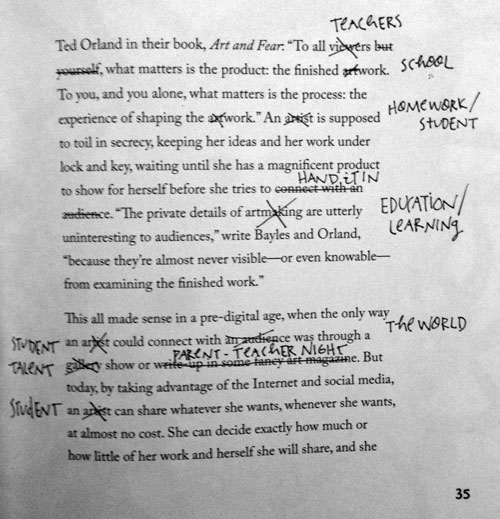One thing that keeps coming up over and over on this tour is that Show Your Work! is not just a book for “creatives.” (I hate that word as a noun, btw.) It’s a book for anybody doing any kind of work that they want to get noticed.
We’re not all artists or astronauts. A lot of us go about our work and feel like we have nothing to show for it at the end of the day. But whatever the nature of your work, there is an art to what you do, and there are people who would be interested in that art, if only you presented it to them in the right way. In fact, sharing your process might actually be most valuable if the products of your work aren’t easily shared, if you’re still in the apprentice stage of your work, if you can’t just slap up a portfolio and call it a day, or if your process doesn’t necessarily lead to tangible finished products.
Maybe we messed up by putting “share your creativity” in the subtitle, but it’s been a pleasure to watch folks who don’t consider themselves “creative” slowly realize that this book is for them, too.
My driver in Miami last week was a former stock broker, and she said she started the book thinking it would have nothing for her but then ended up thinking it was one of the better business books she’s read.
When Tom Seibert interviewed me for AOL Jobs he wondered whether his blue collar readers would get anything out of it. I told him what I told the folks at Leo Burnett in the video above:
My dream is to have a plumber read this book and figure out how he can show his work and get a following and an audience for what he does to help his business along. I want to see a plumber with an Instagram account, teaching me how to fix the aerator on my sink, and then I go to him when I have a really big problem.
I’ve also been really pleased — as someone who thought he’d be a college professor when he grew up — by how many teachers have embraced the book. Kate Bingaman-Burt is already using it in her senior portfolio class, Jason B. Jones wrote about it for academics in The Chronicle Of Higher Education, and @AmyBurvall on Twitter called it “the best book about education that’s not actually about education.” Educator Brad Ovenell-Carter even posted some of his marginalia from the book:

All of this is to say: you just don’t know what case needs to be made for your book until it’s out in the world and you start seeing how readers respond to it.
So, help me spread the word: if you know somebody who doesn’t consider themselves “creative” but they’re trying to get their work out there, consider getting them a copy of the book, and let me know how it goes.
Related: Chase Jarvis and I talked a bit more about the subject in the back of a car at SXSW: